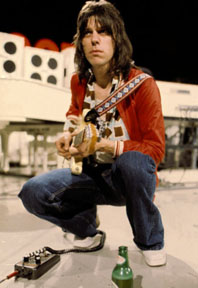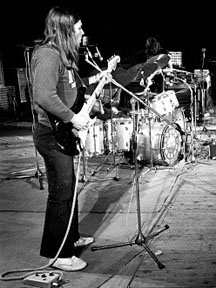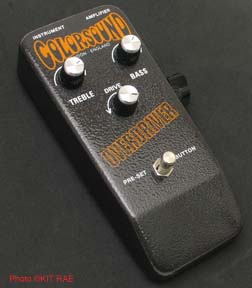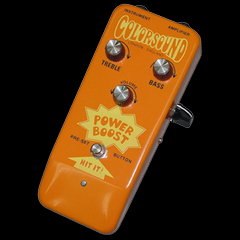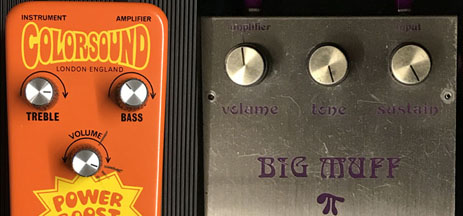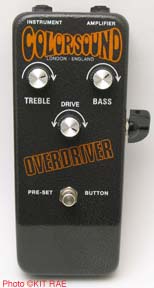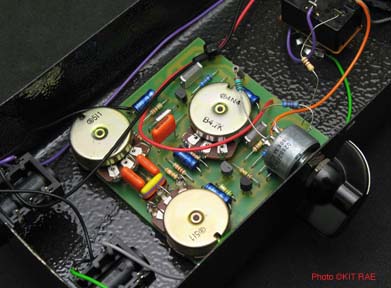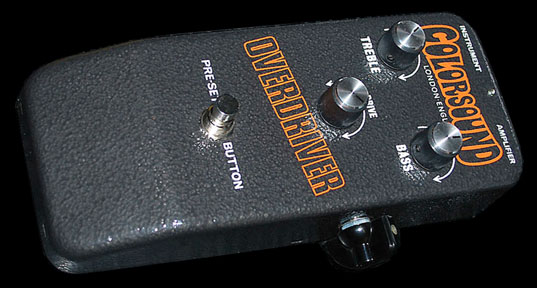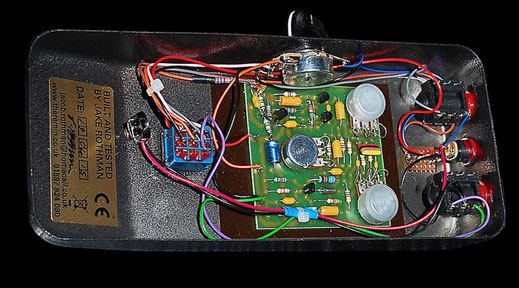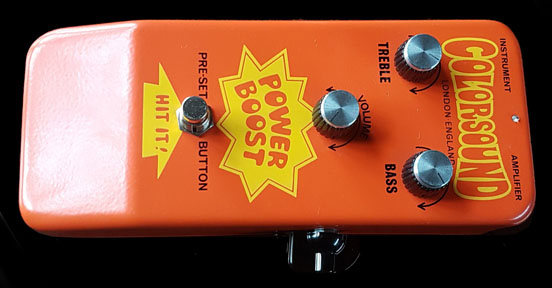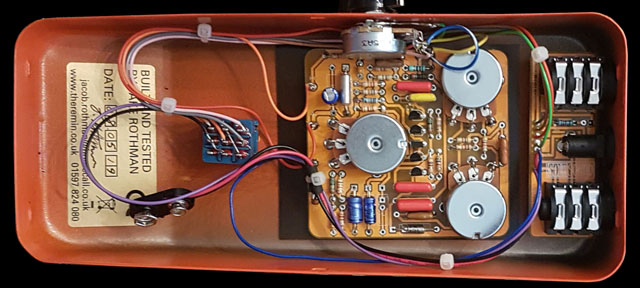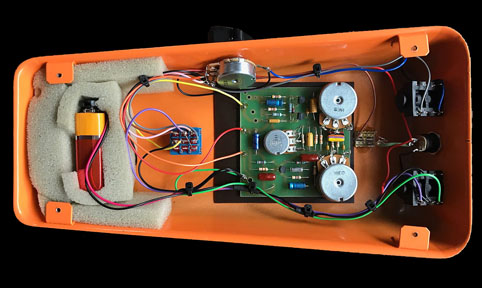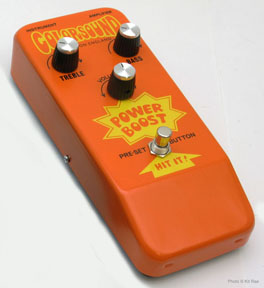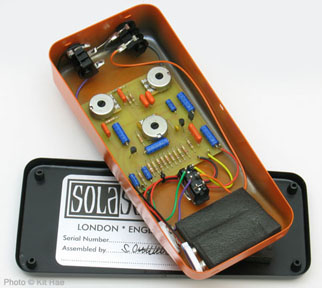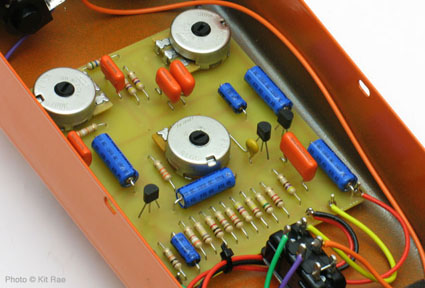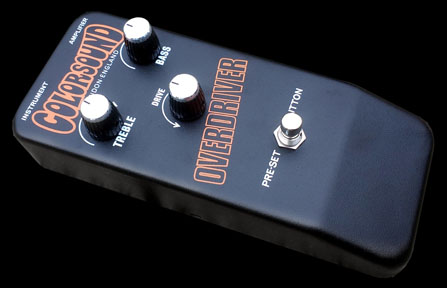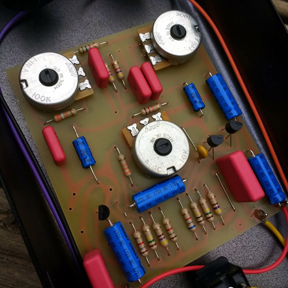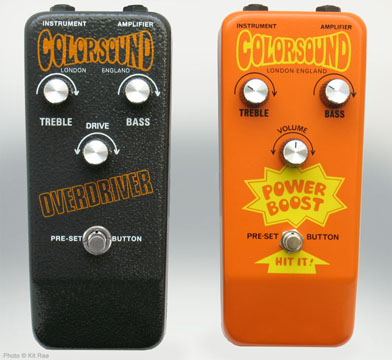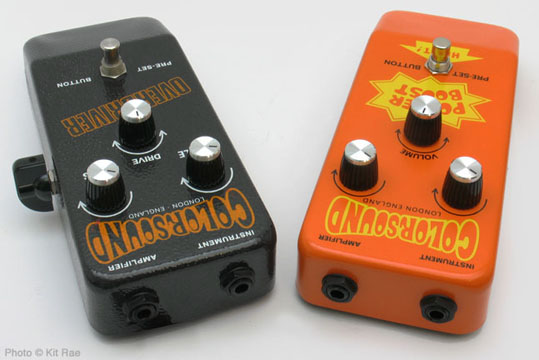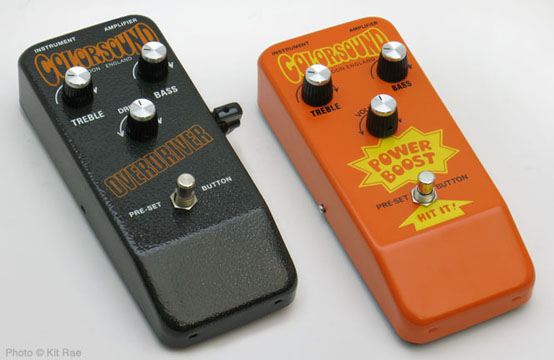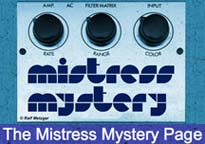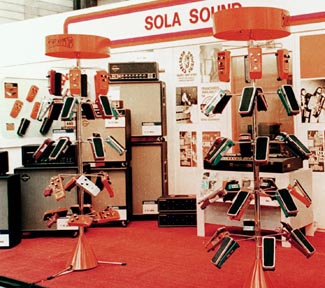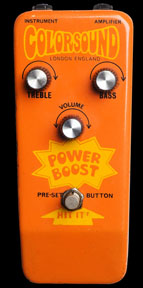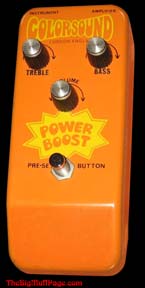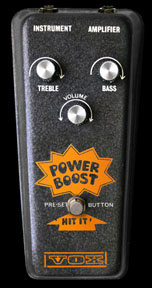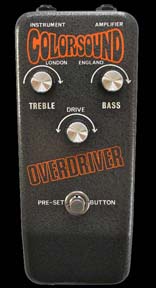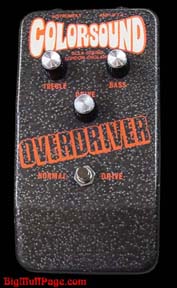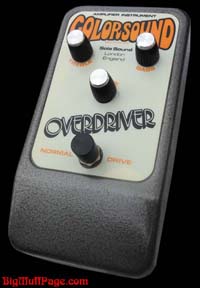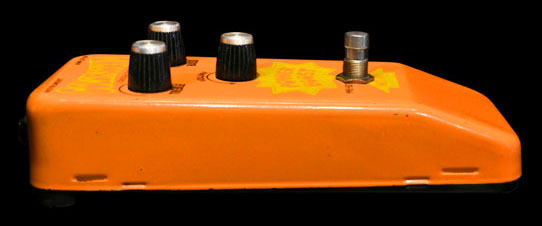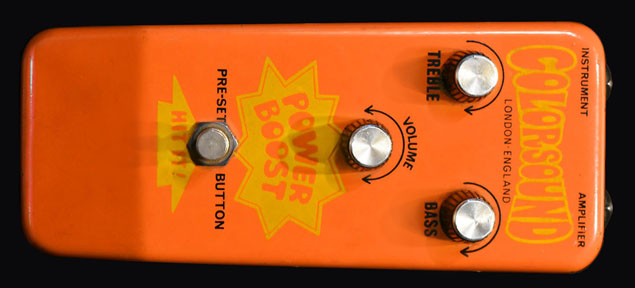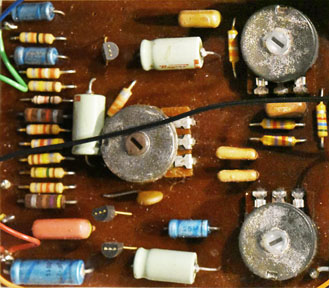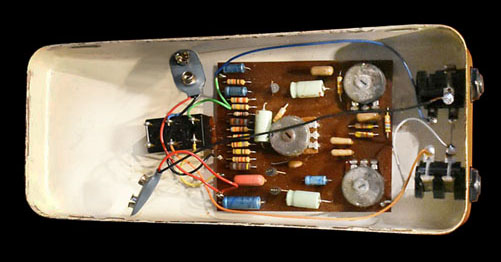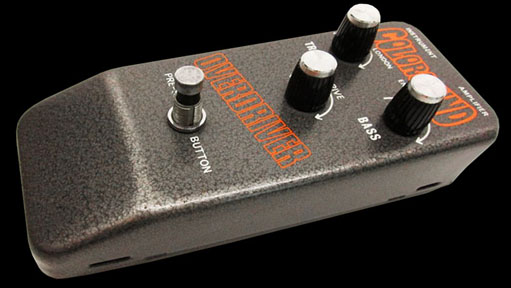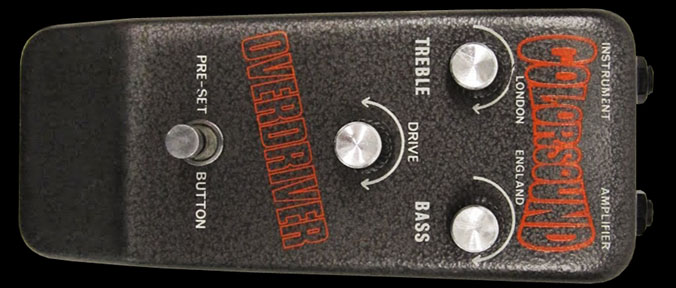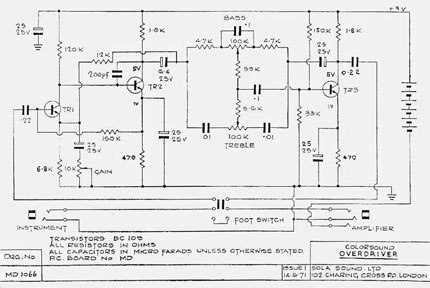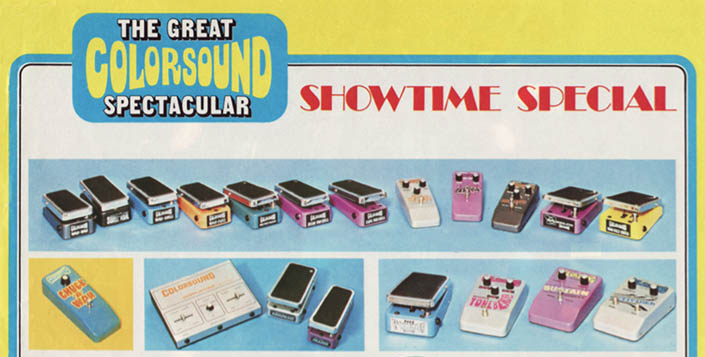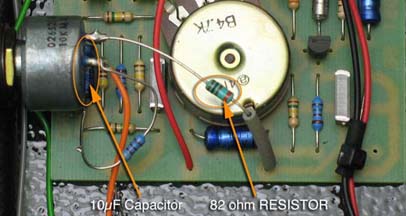NOTE: This website is frequently updated. Article written 2007. Last update September 2023
CLICK HERE TO GO DIRECTLY TO THE DAVID GILMOUR SECTION
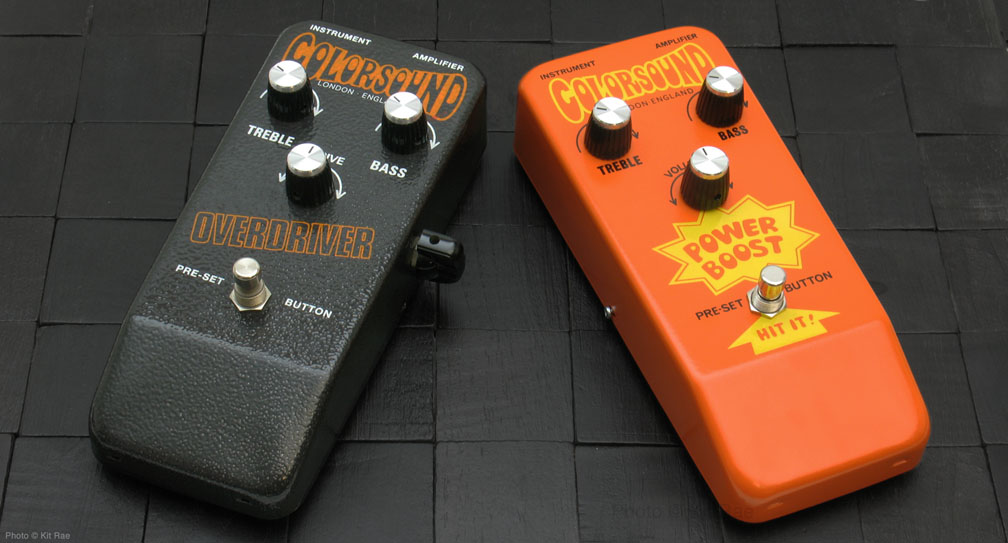
The COLORSOUND POWER BOOST and OVERDRIVER are pieces of British fuzz history that were very popular in the 1970s. They are generally acknowledged to be the first "overdrive" pedals on the market and were sold by the legendary Macaris music store of London. These were essentially pre-amplifiers with a bass and treble boost, designed to drive amplifiers into overdrive or fuzz, and they were LOUD. The Power Boost was the original 18v version of the circuit. It was later changed to run on 9v power and renamed the Overdriver. David Gilmour of Pink Floyd used the old orange Power Boost version throughout the 1970s on such tracks as Shine On You Crazy Diamond, the solo in Have A Cigar, Sheep and many other mid to late late 1970s Pink Floyd songs. He also used it heavily on Pink Floyd's 1972-1977 Pink Floyd tours and was later seen using the Overdriver version in the 1990s. Jeff Beck was another Power Boost/Overdriver user and it can be heard all over his early 1970s studio recordings and live work, including the Blow by Blow album. Other well known users were Jan Akkerman of Focus and Marc Bolan of T Rex. The modern Colorsound Power Boost is a reissue of the classic 18v pedal released in 1969-70. The modern Colorsound Overdriver is a reissue of the classic 9v version of the pedal made in 1971. Both are still distributed by Macari's of London, with master volume Standard Series versions hand made by Jake Rothman of Theremin.co.uk at the time I write this (2011), and non master volume Vintage Series versions made by Stu Castledine of Castledine Electonics.
Jeff Beck using a Colorsound Overdriver in 1972 (left) and David Gilmour using the Power Boost on stage with Pink Floyd in the Netherlands in 1972 (right)
The Power Boost/Overdriver is a very versatile pedal with a number of uses. It creates a very transparent pre-amp boost that sounds dynamic, warm, and open. The bass and treble controls give a wide range of tonal options, including a full-on treble boost. One thing that makes this pedal very difficult to use on a modern pedalboard is the massive head room and volume. It is incredibly loud when switched on, even with the volume/drive knob set to its lowest. The volume boost starts off mostly clean at low volume/drive settings and it increases drastically in volume and gain towards the the end of the volume/drive knob sweep. It can be set for a clean boost, dirty boost, overdrive, or fuzz overdrive distortion. With the volume/drive knob set low it stays very clean with single coil pickups, but with humbuckers it always sounds like the signal is slightly overdriven. At maximum volume/drive, the fuzz overdrive screams with humbuckers, and goes into massive feedback if you have your amp volume too high.
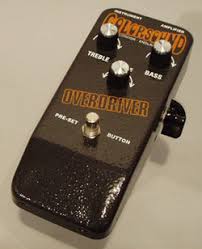
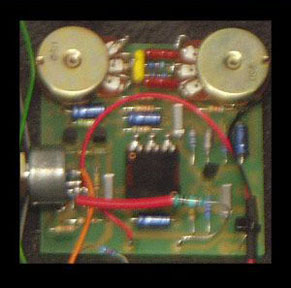
The 1996 9v Colorsound Overdriver reissue with master volume on the side, a feature not found on the originals
The 9v Colorsound Overdriver and 9v Power Boost "Standard Series" reissues with master volumes, built by Jake Rothman circa 2011. These had essentially
the same circuit and sound, but the Overdriver had a different drive pot value so it broke into overdrive earlier in the pot sweep than the Power Boost.
The circuit has a very unique overdrive sound that you won't find with many modern drive pedals. Like a vintage Fuzz Face circuit, when placed first in line after the guitar it becomes integral to the guitar circuit and is very responsive to pick attack. With the volume/drive set high you can pick lighly and get a cleaner sound or heavily for more orverdriven fuzz. The volume/drive control can be a bit difficult to use however. The originals are infamous for not really doing much for 85% of the pot sweep. When you get to the last 10%, the overdrive and volume doors opened wide. In the last 5% a very aggressive fuzz-overdrive distortion blasts in. Nothing quite like it. Below is a sound clip with maximum fuzz.
![]() Fat Old Sun solo with 18v Power Boost - Treble and bass set to 3:00, volume set to maximum. Strat with CS-54 bridge pickup into a Reeves Custom 50 through a Hi-Tone Eclipse cab with Crescendo A speakers.
Fat Old Sun solo with 18v Power Boost - Treble and bass set to 3:00, volume set to maximum. Strat with CS-54 bridge pickup into a Reeves Custom 50 through a Hi-Tone Eclipse cab with Crescendo A speakers.
Many of the reissues have a reverse log volume/drive pot to make that 85% part of the sweep more usable, but there was actually an advantage to the original sweep when using the Power Boost in conjunction with a vintage style fuzz pedal like a Fuzz Face or Tone Bender.
If you run the Power Boost first in line after the guitar, followed by a fuzz pedal, that long volume sweep allows you to fine tune the amount and type of distortion created by both circuits together, along with guitar's volume control. The Power Boost can either smooth out the fuzz, or send into overdriven insanity. This works best with regular output single coil pickups. High output pickups like the Seymour Duncan SSL-5 are more difficult to control. Guitar volume is the key to controlling this setup, and the guitar on full is often NOT the best sound. Dial the guitar volume to 5 or 6, set the Power Boost volume to zero and distortion level on your fuzz pedal to zero. Dial the fuzz distortion up to the desired level (about 12:00 on my Sunface), then adjust the guitar volume until you hit the sweet spot. Conversely, you can leave the fuzz distortion at zero and dial the Power boost volume up into distortion, but I prefer it the other way. You can get some very smooth lead and overdrive tones blending both pedals this way, although it can be a bit noisy. To make the overdrive even more controllable and smoother, add a buffered pedal pedal in between the Power Boost and the fuzz pedal. That is my preferred setup.
![]() 18v Colorsound Power Boost into an Analogman Sunface (Fuzz Face clone) with a Deluxe Electric Mistress -
Example of a huge modulated tone with lots of delay from a Free the Tone Future Factory. The distortion is equal parts Power Boost and Sunface. Strat with a hot Seymour Duncan SSL-5 bridge pickup into a Reeves Custom 50 through a Hi-Tone Eclipse cab with Crescendo A speakers.
18v Colorsound Power Boost into an Analogman Sunface (Fuzz Face clone) with a Deluxe Electric Mistress -
Example of a huge modulated tone with lots of delay from a Free the Tone Future Factory. The distortion is equal parts Power Boost and Sunface. Strat with a hot Seymour Duncan SSL-5 bridge pickup into a Reeves Custom 50 through a Hi-Tone Eclipse cab with Crescendo A speakers.
The Power Boost also works great when blended with an Electro-Harmonix Big Muff, especially an early to mid 1970s Ram's Head Big Muff, the modern Rams Head reissue, or a good clone. You can have the PB be the dominant distortion or the Big Muff, or equally blend the two. The settings below are a blend of the two.
![]() 18v Colorsound Power boost into a Ram's Head Big Muff - Settings shown above. I use a short 90ms slapback delay and a 340ms delay from an FTT Future Factory, low in the mix. Strat with SSL-5 bridge pickup into a Reeves Custom 50 through a Hi-Tone Eclipse cab with Crescendo A speakers.
18v Colorsound Power boost into a Ram's Head Big Muff - Settings shown above. I use a short 90ms slapback delay and a 340ms delay from an FTT Future Factory, low in the mix. Strat with SSL-5 bridge pickup into a Reeves Custom 50 through a Hi-Tone Eclipse cab with Crescendo A speakers.
![]() Colorsound Overdriver into a Ram's Head Big Muff - Just messing around making horrible noise overdriving this old EHX pedal. Strat with CS69 neck pickup and SSL-5 bridge pickup, into a '65 Fender Twin Reverb RI.
Colorsound Overdriver into a Ram's Head Big Muff - Just messing around making horrible noise overdriving this old EHX pedal. Strat with CS69 neck pickup and SSL-5 bridge pickup, into a '65 Fender Twin Reverb RI.
Below is a demonstration of how well the Poer Boost+Big Muff combo works for David Gilmour tones from Pink Floyd’s Animals and The Wall albums. This is a blend of the two sounds through a clean amplifier, using single coil guitar pickups. This setup works best with the PB before the Big Muff in the signal chain.
If you have never been able to get your vintage fuzz pedal into the snarling, gated, craziness you have heard on some old rock recordings, run the Power Boost or Overdriver in front of the fuzz with the Power Boost volume knob set just into overdrive, but not full on fuzz. Dial the distortion knob on the fuzz up until it is on the edge of gating, then adjust the guitar volume until it is just one the edge of being out of control, and bask in the mayhem.
The Power Boost/Overdriver is also a great always-on pedal. It can make just about any tube amp have a more hi-fi sound. At low drive settings it opens up the tone of most tube amps, lightly or heavily coloring the sound, depending on settings. It does not necessarily improve the tone of all amps, but it really makes my Fender and Hiwatt tube amps sound more lively. I found that leaving the pedal on all the time with a very light drive setting (from 9:00-12:00), something I learned from Gilmourish.com, can make tube amps at moderate and low volume sound more like they do with the amps at high volume when there is maximum power tube saturation.
2007 Colorsound Overdriver "Standard Series" reissue with a master volume on the side. Built by Jake Rothman
2015 Colorsound Overdriver "Standard Series" reissue with master volume, power LED, and AC jack. Built by Jake Rothman
Vintage original 18v Power Boosts are very rare and expensive, since they were only made for a few years. Vintage 9v Overdrivers are much more plentiful since they were made into the early 1980s. There have been several different versions of the reissue Overdrivers and Power Boosts sold by Macaris since the 1990s, so those are also relatively easy to acquire. Most reissues run on 9v power, with some made to run 18v. Some had master volumes (originals did not), and some did not. Some had extra features added like power LEDs, input buffers, and AC adaptor jacks. Basically there were two different series of reissue pedals in the 2000s - 2010s, a Standard Series and a Vintage Series. The Standard Series were the versions that included modern features like master volumes, LEDs, and battery holder clips. The Vintage Series were made as close to the original pedals as possible, with no master volumes, no AC jacks, LEDs, or battery holder clip. I have more information on the various reissue versions in the HISTORY section below, but you just have to check Macaris website or drop into their store in London to see what versions they currently offer.
USING WITH BUFFERS - Like other vintage transistor-based fuzz circuits, buffers will affect the sound of the Power Boost/Overdriver. That's not necessarily a negative, and can often be a positive. If you are running an 18v PB with the volume on full, straight into an amp, or with a few non-buffered pedals in between the PB and amp, there is more distortion and the character of the tone is slightly brighter and more trebly than if you place a buffered pedal before or after than PB. You will also find that even with the PB switched off, you tone is brighter than when just running the guitar straight into the amp. A Fuzz Face also reacts with the guitar circuit in a similar manner. Add a buffered pedal between the PB and amp, and some of those highs and amount of distortion are slightly reduced. Obviously that's a negative if you want the maximum fuzzed out distortion available from the PB. However, when using the PB for overdrive, as most people do, the buffered signal can actually make the overdrive sound smoother. That depends on your amp settings and the bass/treble settings on the PB, but when using the PB with my Twin Reverb, Hiwatt, or Bassman amps, I prefer the sound with a buffer following the PB. A buffer placed before the PB also affects the signal in a similar manner, and some reissues PB and Overdrivers aactually had an input buffer. However, to my ears, a buffer before the circuit really alters the full volume maximum fuzz sound in a negative way. I prefer the sound with the PB first in line after the guitar.
POWER - The original 18v Power Boost ran on two 9v batteries. Most of the reissues run on a single 9v, but there have also been 18v Power Boost reissues made. Original Overdrivers and the reissues run on a single 9v battery. Some reissues included a 9V power supply jack to allow power from a standard 9V DC power adaptor. You can also use a 9V battery snap adapter like the 1 Spot CBAT and connect to a standard negative center power supply like the Boss PSA120T, 120S, or 1 Spot 9V AC Adapter. These sound best with non-alkaline type 9v batteries to me, but I have also run them using 9v DC adaptors with no issues.
ENCLOSURE - Nearly all versions are housed the the classic pressed metal Colorsound Tone Bender style case (22cm x 9.6cm), with an orange finish or dark gray hammerite finish. A few versions were made in the larger Tone bender Mk III case. The bottom of the case is removeable for access to the battery. The bottom snapped to the top of the case on originals, and it was rather difficult to open. Reissues used a re-tooled case that uses two screws to hold the bottom on, which is much easier to open.
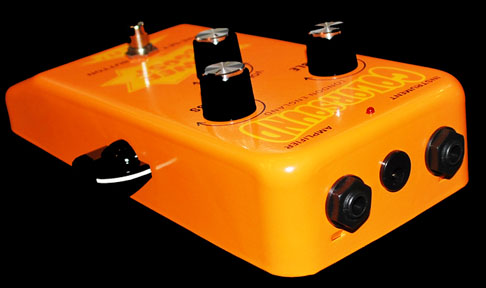
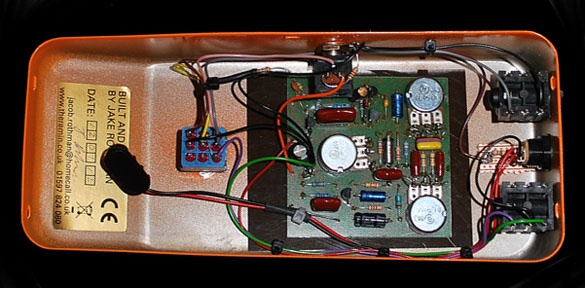
2012 Colorsound 9v Power Boost "Standard Series" reissue with master volume, power LED, and AC jack. Built by Jake Rothman
2018 "Aussie" 9v Power Boost reissue with master volume, power LED, and AC jack. Built by Jake Rothman
2018 Limited 9v Power Boost reissue in the large Tonebender MK III style case, including master volume, power LED, and AC jack. Built by Jake Rothman
WHICH VERSION IS THE BEST? It depends on how you will use it, but I think all of them sound great. If you are just using one to EQ or add some light overdrive to your sound, any of them will work. My favorite would have to be the 18v Power Boost from the Vintage Series, without the master volume. There is something slightly better about the sound with the volume set to maximum and the way it interacts with my guitar's volume knob that I prefer more than the 9v versions. It is a subtle difference, but the tone is slightly better and there is more distortion than the 9v Power Boost and Overdriver Standard Series reissues.
The built-in master volume versions are definitely more versatile, but there is a drawback to the versions I have owned. Even with the master set to zero, the circuit does not allow the volume to go down very low, or even off. The minimum volume level is higher than a typical unity volume level, especially when the drive knob is set high enough for a heavy orverdrive. At high drive settings this makes it almost impossible to use on a modern pedalboard with other pedals at unity volume because the Power Boost/Overdriver will be louder than everything else when switched on.
HOW TO SOLVE THE MASSIVE VOLUME ISSUE - The huge volume boost can be problematic if you want to use a Power Boost or Overdriver on a pedalboard, even if you have a master volume version. If you have a bypass loop switcher, placing the pedal in a bypass loop with a Volume Pedal or a small Master Volume Box in line after it is one way to overcome this. Master Volume Box/Master Volume Pedals are small boxes with only a volume pot and input/output jacks inside. Some have a foot switch, some do not. They are usually passive, meaning they do not require power. The PB/Overdriver has a 10k volume pot, so the Master Volume Box that follows it only needs a 10k pot. Most Master Volume Box/Master Volume Pedals use a 100k or larger pot value. Those larger pots are fine, it's just that the usable part of the volume pot sweep is smaller than a 10k or 25k pot. All that is inside these boxes is the pot and two jacks, so if you have a soldering iron, they are very easy to build your own for under $10. You just need a Hammond 1590A enclosure, two mono 1/4" jacks, a 10k audio potentiometer, and a knob for the pot, and some scrap wire.
If you are using the Power Boost or Overdriver in a pedal board without a loop switcher, get a Loop Switcher Pedal with a volume control, like the Boss LS-2. You place the PB/Overdriver in the loop, set the volume, then you simply switch the LS-2 on when needed. Keep in mind that many loops switchers, like the LS-2, have input buffers before the loop, and that will affect the tone and amount of distortion from the PB/Overdriver when it is in the loop.
If you just use the pedal as a volume boost or EQ, it is possible to use a master volume version on a pedal board. Set the volume/drive knob and master volume to mimimum. Or you can place the pedal first in line in your signal chain and leave it always on so it's volume is the unity volume for everything that follows in the signal chain.
The "Vintage Series" Colorsound 18v Power Boost reissue built by Stu Castledine, copied directly from his 1972 original
which had the final version of the 18v circuit and BC184L transistors
The "Vintage Series" Colorsound 9v Overdriver reissue built by Stu Castledine
DIFFERENCE BETWEEN THE POWER BOOST AND OVERDRIVER - There is a lot of contradictory and confusing information out there about this. Does the 18v Power Boost sound different than the 9v Power Boost? Does the 18v Power Boost sound different than the Overdriver? The simple answer is, some sound different and some do not, depending on which of the many different versions you have and what voltage it runs. The main difference with most of the originals from the 1970s is that there is slightly less headroom and output with the lower powered 9v Overdriver than the 18v Power Boost. That just means that the Power Boost volume is much louder than the Overdriver. You also hear more overdrive slightly earlier in the volume/drive pot sweep on the Overdriver than you do with the Power Boost, and very slightly more overdrive distortion on the Overdriver when the volume/drive is set to maximum. But depending on which reissue version you have, it could be the opposite, or there may be no difference. Below is a breakdown.
There is a slight difference in tone when the tone knobs are set the same on some Power Boosts and Overdrivers, but all you have to do is tweak the bass and treble settings slightly on one to make it sound 95% the same as the other. When the volume/drive is set anywhere below 4:00, I can get just about any version of these pedals sound nearly the same by adjusting the bass/treble and volume/drive knobs to match. In the light drive settings I typically use, most of the Overdrivers and Power Boosts I have played or own sounded practically identical, and most people would not be able to hear any difference in a blind test. It's when you set the volume/drive pot to that last 15% that the differences, or similarities, become apparrent.
Vintage Colorsound Originals - There were two versions of the original 18v Power Boost circuit and the bass/treble frequency response and amount of overdrive distortion was basically the same on both. The original 9v Overdriver circuit was nearly identical to those 18v circuits, just set up to run on a lower voltage, so the volume was not as loud. There were a few circuit components that have to do with the voltage handling that were different, but as far as the sound was concerned, they both sound the same until the volume/drive pot is set to maximim. Then you would hear a very slight difference in the amount of distortion, but the amp-like character of the distortion was basically the same on both. Keep in mind that you can compare two vintage Power Boosts and find they only sound 90-95% the same, or two vintage Overdrivers, so even the originals of the same circuit may not sound identical today. My late '70s wide body Overdriver had slightly more overdrive distortion than a '72 original I borrowed to compare it to.
96 Reissues and Standard Series Colorsound Reissues - The 1996 9v Overdriver reissue from the mid 2000s actually had the exact same circuit inside as the 96 reissue Power Boost, which was 9v, not 18v. The Standard Series 9v Overdriver reissue from the mid 2000s also had the exact same circuit inside as the reissue Power Boost, which was 9v. Eessentially these were all Overdrivers, so they sounded identical. Later the Standard Series Overdriver volume pot was changed so it had a bit more breakup than the 9v Power Boost, but the difference was minimal. Compared to an original 18v Power Boost or Vintage Series 18v reissue, the Standard Series has much less volume and much less overdrive distortion with the volume/drive pot at maximum. Through a clean amp, the 9v circuits only reach overdrive with the pot maxed, but 18v circuits can be pushed farther into an amp-like fuzz distortion. Through a dirty amp, or when using high output pickups, both push into fuzz distortion, but the 18v is much more extreme.
Standard Series 9v Power Boost reissue with volume pot set to maximum - My 2007 9v Overdriver reissue sounds basically the same as this.
Vintage Series Colorsound Reissues - The Vintage Series 18v Power Boost and 9v Overdriver reissues are more accurate representations of the originals than the Standard Series. Other than the volume being louder in the Vintage 18v PB than the Vintage 9v Overdriver, there is very little difference. When the volume/drive pot is set to maximum the PB has slightly more distortion than the Overdriver, when you take the volume difference out of the equation. Both have the same amp-like character to the distortion. The Vintage 18v Power Boost reissue has much more overdrive distortion with the volume at maximum than the Standard reissue 9v Power Boost/Overdriver, and an original 1972 Overdriver I borrowed to compare it to. My late '70s wide body Overdriver had slightly more overdrive distortion than the '72 original, much more than my 2007 Standard Overdriver reissue, and about the same as the Vintage 18v Power Boost reissue.
Confused yet? There are more versions of the reissues than I list here, and I have not played them all, so this is only from my experience.
Vintage Series 18v Power Boost reissue with volume pot set to maximum
Vintage Series 9v Overdriver reissue with volume pot set to maximum
18v Colorsound Power Boost and 9v Overdriver reissues
HISTORY - Macaris Musical Exchange is the longest running music instrument retailer in central London. Their sister company was Sola Sound, creators of the legendary Tone Bender fuzz, among other classic pedals. Around 1969-1970 Sola Sound launched their Colorsound line of effects pedals and the 18v Power Boost was one of the first pedals in the Colorsound line. The Power Boost ads I have come across first appeared in 1970. They were encased in a bright orange enclosure with very 1960s looking graphics by Alan Murray. It was a hit in London, but that color and graphics style did not go over too well when it was shown to the America market at a Dallas Texas trade show, so around 1971 (factory schematic dates 14.6.71) it was repackaged in a dark gray enclosure, changed to 9v power, and renamed the Overdriver. Supposedly Marc Bolan of T Rex suggested that name. There was also a version of the Power Burst made for Vox in a different enclosure (Tone Bender Mark III case) around this time, in the same gray color as the Overdriver, but using the original Power Boost circuit.
Vintage 1970 Colorsound Power Boost ad and Sola Sound trade show booth from 1970 displaying the new Colorsound line, including the orange Power Boost
(L to R) Original 1969 18v Power Boost, 1972 Power Boost, rare Vox Power boost, 1971 9v Overdriver, 1975 Overdriver in wide box, and late '70s Overdriver with white label.
The "Hit It" arrow in the 18v Power Boost graphics below the footswitch was dropped sometime in the early 1970s, then the pedal was discontinued around 1972. The 9v Overdriver circuit that replaced it was similar to the 18v circuit, just set up to run on a lower voltage. There were also some Power Boosts made in the mid 1970s that ran on 9v, which were essentially Overdrivers with the Power Boost graphics. Both versions were housed in the original Tone Bender style, pressed sheet metal cases. They were later rehoused in the wide-body Supa Tone Bender style case in the mid 1970s, with a white label added to the top in the late 1970s. Originals never had a master volume pot, but sometime in the late 1970s the factory started adding them due to requests. The master volume was a custom mod that had been done to original units, but never offered directly from Sola Sound before this.
original Colorsound Power Boost with 18v circuit from 1969-70

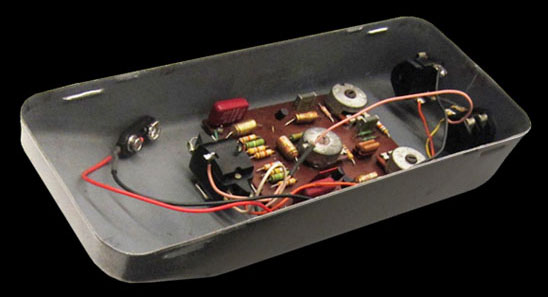
original Colorsound Overdriver from 1973
There were two slightly different schematics for the original 1970s Power Boost and one for the Overdriver. There have also been slight changes to vlaues of some circuit components over the years, as well as several different types of Silicon transistors used. The circuit topology is a variation of the typical fuzz circuits of the time, like the Tone Bender and Fuzz Face. The original circuit was possibly "designed" by electonics engineer Gary Hurst, creator of the Sola Sound Tone Benders, and many other Sola Sound/Colorsound circuits, although I have never seen confirmation of this. Gary mentioned he was working on a new foot pedal with a bass and treble boost back in the January 1966 issue of Beat Instrumental, when British booster units were very popular. It was described as being a volume pedal. Gary did design a bass and treble booster housed in a volume pedal case for CBS/Arbiter, called the Power Driver, although that was much later in 1974 or 1975. Regardless of who designed it, schematics for the essential parts of the circuit already existed. There were sample schematics for an 18v microphone preamp circuit and an 18v tone control circuit shown in Valvo and Mullard transistor application books in 1970 that are nearly identical to the amplification and tone stages found in the Power Boost. The design was likely taken and adapted from those, which was a common thing for engineers to do at the time when speed and economy were required in getting a product to market. Transistor companies were in the business of selling transistors, so they offered these application designs for free to give engineers ideas for how to use thier products.
1971 Overdriver schematic and 1975 Colorsound ad showing the Overdriver
Colorsound pedals continued to be made until the early 1980s, then all production stopped. In 1996 the line was resurrected. Legendary Vox engineer Dick Denney worked with Macaris on the reissues, including a 9v Power Boost and Overdriver. It was one of the last pcbs he worked on before he died in 2001. The reissue incorporated a much needed master volume knob into the design, but there were also a non master volume versions made. The words POWERBOOST 96 are marked on the circuit board of these reissues. The '96 reissues were short lived but Anthony and Steve Macari continued with the line in the 2000s. Rather than build the pedals in house as had been done in the past, or contracting a factory to make all of their pedals, Macaris went an unusual route and used several different renowned custom makers to hand build their pedals. Builders like Jake Rothman of Theremin, David Main of D.A.M, and Stu Castledine of Castledine Electronics.
In the 2000s-2010s there were two different series of reissue Power Boost and Overdriver pedals, a Standard Series and a Vintage Series, and there were several revisions and improvements made to them throughout the years. Most Standard Series pedals had a master volume, so that is the easiest way to identify which series it came from. They also had battery holder clips inside, attached to the upper or lower body. The early 9v Power Boost reissues had a circuit identical to the 9v Overdriver reissue, so in that sense those 9v Power Boosts were really just Overdrivers with Power Boost graphics. A master volume was added to the 9v Power Boost reissue sometime in the mid 2000s. Later, around 2012, the Power Boost reissue was given a different volume pot value so it broke up later in the knob sweep, more like the originals. The Standard Series reissues were built by Jake Rothman.
In 2008 Jake revised the Colorsound Standard Series Overdriver circuit to add a FET buffer at the input, supposedly improving the guitars tone control interaction with the circuit. The same was also done to the Standard Series Power Boost and Macaris claimed it made the circuit sound more aggressive. Other Standard Series revisions were made, including briefly adding an AC adaptor jack and power LED (circa 2012) to both the Overdriver and Power Boost, and changing the drive pot to anti-log on both, giving a wider gain spread. Macaris sold a special limited edition run of Overdrivers made by Jake in 2012 with an OC140 Germanium transitor. There was also a "Limited Run" version of the Power Boost made in 2014. The Standard Series was dropped from the line in 2016. In 2018 another Limited Run Power Boost in the Vox style wedge case was made by Jake that ran on both 9v or 18v. An "Aussie" version was also made in 2018, part of a special run Jake made for the Australian Pink Floyd band. It was basically the same spec as the Standard Series version Jake made in the early 2000s.
Beginning around 2012 Macaris began selling very accurate "Vintage Series" replicas of their original pedals. These were made as close to the original specs as posible, including more accurate silk screened graphics by Electric Warrior. The 2012 Vintage Series replica of the original Power Boost was made to run on 18v like the originals from over 40 years earlier, rather than 9v like the previous reissues. It was built by Stu Castledine, based on his 1972 Power Boost. It ran on two 9v batteries. The only real difference between his original and the reproduction is that he used a reverse-log volume pot rather a log pot. This gave it wider volume and gain sweep. In 2018 Stu also made a very accurate vintage 9v Overdriver replica for Macaris. It can be differentiated from the previous Standard Series version by the fact that it has no master volume knob on the side and has a dull black finish, rather than the shiny gray hammerite finish of the Standard. It has more distortion when the drive pot is set to maximum than the Standard Series Overdriver, and slightly less distortion than the 18v Power Boost. (Thanks to Philip, Stu, and Jake for additional info).
I'm sure I am missing some other variations of the reissues, but suffice it to say, there were many!
CLONES - There have been numerous, less expensive clones made of the Power Boost/Overdriver over the years that include built in master volumes. Too many to list or keep up with, but Gilmourish.com always has a good llist of the alternatives available. A few clones I have tried that sound good are the Throbak Overdrive Boost, Vick Audio Overdriver, Buffalo FX Power Booster, Vintage FX Colordrive, and Prescription Electronic RX Overdriver. Most of these sound like they were inspired by the originals and do not sound exactly like the original Sola Sound pedals I own, but are very close. The 18v Buffalo FX Power Booster is one of the better ones. A Boss BD-2 Blues Driver also gets in a similar tone territory.
MINUMUM VOLUME MOD - If you desire the master volume pot on your Master Volume 9v Power Boost or Overdriver reissue to go closer to zero instead of the stock mimunum volume, you can do this simple mod. Remove the 82ohm resistor (circled in red in the photo below) coming off the ground pin of the volume pot. Run the wire straight from that pin to the board, without the resistor. (thanks to Jake Rothman for the mod)
REDUCED GAIN MOD - If you do not like the trademark clipping spike on your Master Volume 9v Power Boost or Overdriver reissue when the volume/drive pot is set to maximum fuzz (although who would not like this?) and desire the gain to be reduced slightly for more of an overdrive sound, you can remove the 10uF electrolytic capacitor under the volume pot and run a wire in its place. This will reduce the gain by 6db. (thanks to Jake Rothman for the mod)
Kit’s Secret Guitar, Gear, and Music Page
Guitar stuff, gear stuff, soundclips, videos, Gilmour/Pink Floyd stuff, photos and other goodies.
Copyright Kit Rae.
VISIT MY SWORDS, KNIVES and FANTASY ART WEBSITE www.kitrae.net

